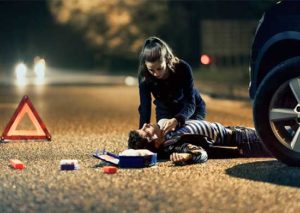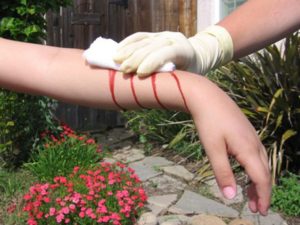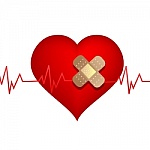How to ride your bike safely on the road – Though motorized two-wheelers bikes provide speed at a low cost, they do not provide safety. A two-wheeler accident usually proves more damaging and more expensive than one on a bike or in a car
Tips on how to ride your bike safely on the road !
To reduce the frequency and severity of accidents, one should follow all the defensive and safety procedures. Keep the vehicle properly maintained. Check the conditions of clutch, brakes, light, horn, tyres and fuel gauge, orientation of rear view mirror etc.
Not more than two persons should ride on it. Each one should wear a helmet securely fastened. These are among the most important points to remember, when you want to ensure that you ride your bike safely on the road.
Monitor the traffic behind, using the rear-view mirror to see if someone is trying to overtake. Give him way as soon as it is safe to do so. Keep an eye out for pedestrians, cyclists, school-children, animals, slippery roads, pot-holes, etc.
Follow all the road safety rules, overtake with extreme caution if you must, and maintain a safe distance from the vehicle ahead of you. Be extra careful at night and during bad weather such as rain, dust-storm, etc.
Carry a first-aid box for emergency use. It is very important to control speed when going downhill. Also, if you are tired or/and caught in heavy traffic, or when the road is uphill, walk with your bike rather than ride on it.
How to ride your bike safely on the road after rainfall
In rain, take care that your raincoat does not get stuck in a wheel or pedal. During or after rainfall or snowfall, the road is likely to be slippery. Ride slowly and watch out for oil patches, water puddles, icy patches, etc.
Do not brake hard lest you skid and fall. Keep good distance from other traffic since bikes as well as other vehicles need longer distances to come to a stop on a wet road. Be cautions and turn slowly on such roads.
Riding bikes in bad weather
In cold weather, protect your hands with appropriate gloves but ensure that hand movement or grip is not restricted. Ride slowly during bad weather.
If you have to stop in a hurry, do not completely slam on the front brakes. This could result in skidding of the bike. Apply both the brakes cautiously and gradually.
Tips on how to ride a bicycle safely on the road !
In any accident involving a cycle and a car, regardless of who is at fault, the cyclist suffers the most. Therefore, it is in the cyclist’s own interest to be very careful while riding and when being overtaken by vehicles.
Be careful on roads under repair and pieces of stones or other items lying on the road. Be watchful of pedestrians, pets or stray animals suddenly coming onto the road to cross it. Be careful of motorists trying to jump a traffic signal, and a bus or truck making a wide turn, etc.
Keep an eye on the traffic around you, and adopt all the safety measures, some of which are listed below. Children and learners should not ride on the main road until sufficiently experienced.
Since over two-thirds of the accidents occur at intersections, turns, etc. signal your intention at least 30 meters before turning and carefully observing the traffic signals and signals of other vehicles are very important for safe riding.
The cycle should be of the right size, neither too small nor too big. A wrong size can cause discomfort and may not be easy to handle and control efficiently. For riding comfort, safety and longevity of the bicycle, it should be properly maintained.
Safety measures and precautions involves :
Keeping the tyres inflated to the correct pressure. Adjusting the brake shoes to be within 3 mm of the rim and ensuring that they are in good shape; Oiling and greasing the components as recommended.
If you ride the bike a lot, and specially over long stretches of roads where there are no repair shops, learn how to do simple repairs such as mending a puncture etc. Carry essential repair tools in a bag, including a small air pump.
A bicycle should have the following accessories for safety: headlight, rear light, horn and bell, rear-view mirror, front and rear reflectors, pedal reflectors, spoke reflectors.
Wearing reflector armbands and leg bands makes a cyclist more visible to other vehicle drivers on the road at night. Even if the law does not require it, one should always wear a helmet, especially if there is a lot of traffic on the road.
Reflector strips on the helmet make for better visibility and be careful of traffic on blind curves. On the road, a bicycle is a vehicle and not a toy. Therefore, do not ride it in a reckless fashion or race with others.
Do not cycle holding it with one hand, or without holding the handle bar, even on a road with light traffic. You may be thrown off the cycle and you can get hurt badly. Do not wear any ear plugs or headsets in your ears. This would hinder your hearing traffic noise and horn sounded by another vehicle.
More important tips for riding safely on the road
Whilst cycling, do not carry load, or a small child in your lap or on your shoulder. This would be unsafe for you, the child, as well as other road users.
If an extra person is to ride, there should be a carrier at the back. Ensure that the passenger’s foot does not get caught in the moving spokes. Install a barrier between the rear wheel and the child’s leg.
For small articles, books, etc. have a basket or a carrier or both so that your hands are free. Watch out for items and clothes that dangle. They may get into the spokes. This includes purses, bags, sarees and the lower end of wide trousers or pajama legs.
Use less-travelled roads and plan you itinerary thoughtfully. Do not cycle on highways where the traffic moves fast. It is very unsafe, unless bicycle lanes exist separately. It may be unlawful to cycle on pavements and pedestrian pathways. You may hit someone and both may be injured.
While riding in a cycle lane be on the lookout for cars backing out, children rushing out of houses, etc. Take extra precautions when coming onto the main road from the cycle lane.
On the road, ride as close to the sidewalk as is possible, not in the middle of the road where the traffic moves at a higher speed. Do not ride very close to parked cars. You could be pushed off your cycle by a car door suddenly opening.
Blindspots, headlights and stray dogs
Motorists have blind spots in the rear corners where other vehicles are often not visible in the rear-view mirror. Do not ride in these blind spots. Fast moving buses and trucks cause air turbulence which can unsettle a cyclist. Stay at a safe distance from such vehicles.
If several people are cycling together, form a single file so as not to obstruct the traffic. This will also minimize the chances of any accident.
At night, do not look directly at the headlights of the vehicles approaching you. This could interfere with your vision and blind you temporarily, and you may not be able to spot pot-holes, pedestrians crossing the road, etc.
If the road is covered with loose gravel, sand, or fallen leaves then get down and walk with your bike since riding is not easy under such conditions. Avoid pot-holes and broken manholes. These can cause damage to the bike and may also result in the rider falling down.
Since dogs have a habit of chasing cyclists and it is often difficult to pedal fast enough to move out of the harm’s way due to the traffic, it is best to get down and walk slowly past a dog. If possible, walk with the bike between yourself and the dog. Never ride a bicycle in the wrong lane or on the wrong side of the road.
RELATED TOPICS
Best hospitals in North Carolina
Air travel with medical conditions



